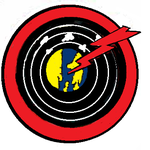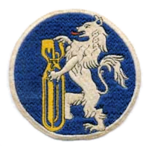379th Bombardment Squadron
| 379th Space Range Squadron (formerly 379th Bombardment Squadron)  | |
|---|---|
 379th Space Range Squadron field training at Schriever SFB | |
| Active | 1942–1945; 1947–1949; 1952–1965; 2012–present |
| Country | |
| Branch | |
| Role | Range management |
| Part of | Air Force Reserve Command |
| Garrison/HQ | Schriever Air Force Base |
| Motto(s) | Volentes et Valentes (Latin for 'Willing and Able')[1] (after 1958) |
| Engagements | China Burma India Theater[1] |
| Decorations | Distinguished Unit Citation Air Force Outstanding Unit Award[1] |
| Insignia | |
| 379th Space Range Squadron emblem[2] (restored) |  |
| 379th Bombardment Squadron emblem[a][1] |  |
| Patch with 379th Bombardment Squadron emblem[3] |  |
| World War II tail markings[3] | Yellow horizontal stripe (310th Group) with narrower white horizontal stripe below (for 379th Squadron) |
The 379th Space Range Squadron is an Air Force Reserve unit. It is assigned to the 926th Wing at Schriever Air Force Base, Colorado. It is a reserve associate squadron of United States Space Force's 25th Space Range Squadron.
The squadron was first active during World War II as the 379th Bombardment Squadron, becoming a medium bomber unit a month after it was activated. After training in the United States, it deployed to the Mediterranean Theater of Operations, where it participated in Operation Torch, the invasion of North Africa. It moved forward with American ground forces. The squadron was awarded a two Distinguished Unit Citations for its actions in combat. Following V-E Day, the squadron was inactivated in theater.
The squadron was again activated in the reserve in 1947. It does not appear to have been fully manned or equipped with operational aircraft before it was inactivated in 1949. It was activated in Kansas as a Strategic Air Command strategic bomber unit. It was inactivated on 25 March 1965 as the Boeing B-47 Stratojet bombers it flew were removed from service.
History
World War II
Initial organization and training
The squadron was activated at Davis-Monthan Field in March 1942 as the 379th Bombardment Squadron, one of the four original squadrons of the 310th Bombardment Group.[4][5] It moved the same day to Jackson Army Air Base, Mississippi, where it began training with North American B-25 Mitchells.[1] A portion of the ground echelon sailed for the United Kingdom aboard the RMS Queen Mary on 5 September 1942[b], while the remainder sailed directly for North Africa from the United States. The air echelon ferried the squadron's Mitchells via the North Atlantic ferry route, but bad weather delayed their movement, with the bombers arriving at RAF Hardwick between October and December 1942.[6]
Combat in the Mediterranean heater

In November 1942, the squadron flew its planes to Mediouna Airfield, French Morocco, to support Operation Torch, the invasion of North Africa, although some remained behind in England until as late as March 1943.[6] The squadron engaged primarily in air support and interdiction in Tunisia, Sicily, Sardinia, Corsica, Italy and Southern France. Through May 1943, it also attacked shipping and harbor facilities to cut the logistics lines of the Afrika Corps. It bombed marshalling yards, rail lines, highways, bridges, viaducts, troop concentrations, gun emplacements, shipping, harbors and other objectives in North Africa.[4] It moved forward to Tunisia with the allied forces, locating at Dar el Koudia Airfield in June.[1] It bombed airfields, landing grounds and gun emplacements, supporting Operation Corkscrew, the reduction of Pantelleria and Lampedusa islands during June 1943. The following month it supported Operation Husky, the invasion of Sicily.[4]
On 27 August 1943, the squadron conducted a mission against marshalling yards in Benevento, Italy. Despite heavy antiaircraft artillery, it effectively bombed the target and destroyed several enemy interceptor aircraft making persistent attacks. For this action, it was awarded the Distinguished Unit Citation (DUC). From August 1943 to the end of hostilities in the spring of 1945, it struck German lines of communication, bridges, rail lines, marshalling yards, viaducts, tunnels and road junctions in Italy. From January through June 1944, it gave air support to ground forces in the drive toward Rome. The squadron also engaged in psychological warfare missions, dropping propaganda leaflets behind enemy lines.[4]
In August 1944, it supported Operation Dragoon, the invasion of southern France from its base in Ghisonaccia Airfield, Corsica. On 10 March 1945, the squadron maintained close formation in the face of severe antiaircraft fire in successfully attacking the railroad bridge at Ora, a vital link in the German supply line to Italy. For this action, it was awarded its second DUC.[4] In April 1945, it moved to Italy and was inactivated in theater in September 1945.[1]
Air Force Reserve
It was reactivated at Bedford Army Air Field as part of the reserve in June 1947, although it is unclear whether or not the squadron was fully manned or equipped with operational aircraft. It was inactivated in June 1949.[1]
Strategic Air Command
The squadron was activated in 1952 as a Strategic Air Command squadron. The unit received Boeing B-29 Superfortress bombardment training from the 90th Bombardment Wing between April and August 1952.[citation needed] It acted as a training squadron until 1954[citation needed] when it replaced the propeller-driven B-29s with new Boeing B-47E Stratojet swept-wing medium bombers. These aircraft were capable of flying at high subsonic speeds and were primarily designed for penetrating the airspace of the Soviet Union. By the early 1960s, the B-47s were considered to be reaching obsolescence, and were being phased out of SAC's strategic arsenal.[citation needed] They were sent to AMARC at Davis–Monthan Air Force Base in early 1965. The squadron was inactivated in March.[1]
Space range unit
The squadron was redesignated the 379th Space Range Squadron and activated at Schriever Air Force Base, Colorado on 1 April 2012.[7] It serves as a reserve associate squadron with the regular Air Force 25th Space Range Squadron.[8] In 2014, the squadron's gaining command changed from Air Force Space Command to Air Combat Command. The squadron has participated in exercises Austere Challenge, Anakonda and Juniper Cobra in Europe; Global Thunder, Global Lightning, Ardent Sentry and Red Flag in the United States; and Valiant Shield in the Pacific.[9]
Lineage
- Constituted as the 379th Bombardment Squadron (Medium) on 28 January 1942
- Activated on 15 March 1942
- Redesignated 379th Bombardment Squadron, Medium c. 20 August 1943
- Inactivated on 12 September 1945
- Redesignated 379th Bombardment Squadron, Light on 11 March 1947
- Activated in the reserve on 9 August 1947
- Inactivated on 27 June 1949
- Redesignated 379th Bombardment Squadron, Medium on 15 March 1952
- Activated on 28 March 1952[10] (not operational until 4 March 1952)[11]
- Discontinued and inactivated on 25 March 1965[7] (not operational after 25 February 1965)[11]
- Redesignated 379th Space Range Squadron on 14 February 2012[7]
- Activated on 1 April 2012[7]
Assignments
- 310th Bombardment Group, 15 March 1942 – 12 September 1945
- 310th Bombardment Group, 9 August 1947 – 27 June 1949
- 310th Bombardment Wing (later 310th Strategic Aerospace Wing), 28 March 1952 – 25 March 1965[10][11]
- 310th Operations Group, 1 April 2012[7]
- 926th Operations Group, 2014[9]
Stations
|
|
Aircraft
- North American B-25 Mitchell, 1942–1945
- Boeing B-29 Superfortress, 1952–1954
- Boeing B-47 Stratojet, 1954–1965[10]
See also
- List of United States Air Force squadrons
- List of B-29 Superfortress operators
- List of B-47 units of the United States Air Force
References
Notes
- Explanatory notes
- ^ Approved 21 January 1958. Description: On a red disc, a black target edged white and bearing three white concentric rings; surmounting the center of the target a globe, land areas Air Force golden yellow, water areas Air force blue; above the globe and surmounting the target six small white clouds; issuing from sinister chief and surmounting all, a red lightning flash edged white pointing to the center of the globe.
- ^ Freeman refers to this as the air echelon on page 265, but contradicts this on page 15, which has more detail on the 310th Group's time in England.
- Citations
- ^ a b c d e f g h i Maurer, Combat Squadrons, pp. 468-469
- ^ No byline (10 March 2016). "379th SRS NCO named Outstanding Airman of the year". 926th Wing Public Affairs. Retrieved 13 April 2018.
- ^ a b Watkins, pp. 80–81
- ^ a b c d e Maurer, Combat Units, pp. 184-186
- ^ Maurer, Combat Squadrons, pp. 468-471, 525-526
- ^ a b c Freeman, p. 265
- ^ a b c d e f Research Division, Air Force Historical Research Agency, Air Force Organization Change Status Report, April 2012, Maxwell AFB, AL
- ^ Ontiveros, TSG Nicholas (3 March 2013). "379th is now official". 310th Space Wing Public Affairs. Retrieved 12 April 2018.
- ^ a b D'Ambrosio, Maj Jessica (13 July 2016). "379th SRS welcomes new commander". 926th Wing Public Affairs. Retrieved 12 April 2018.
- ^ a b c Lineage, including assignments, aircraft and stations through 1963 in Maurer, Combat Squadrons, pp. 468–469
- ^ a b c Ravenstein, pp. 158–159
- ^ Station number in Anderson, p. 19.
- ^ Mueller, p.221
- ^ Station information through March 1963 in Maurer, Combat Squadrons, pp. 468-469, except as noted.
Bibliography
![]() This article incorporates public domain material from the Air Force Historical Research Agency
This article incorporates public domain material from the Air Force Historical Research Agency
- Anderson, Capt. Barry (1985). Army Air Forces Stations: A Guide to the Stations Where U.S. Army Air Forces Personnel Served in the United Kingdom During World War II (PDF). Maxwell AFB, AL: Research Division, USAF Historical Research Center. Retrieved 1 March 2021.
- Freeman, Roger A. (1970). The Mighty Eighth: Units, Men and Machines (A History of the US 8th Army Air Force). London, England, UK: Macdonald and Company. ISBN 978-0-87938-638-2.
- Maurer, Maurer, ed. (1983) [1961]. Air Force Combat Units of World War II (PDF) (reprint ed.). Washington, DC: Office of Air Force History. ISBN 0-912799-02-1. LCCN 61060979.
- Maurer, Maurer, ed. (1982) [1969]. Combat Squadrons of the Air Force, World War II (PDF) (reprint ed.). Washington, DC: Office of Air Force History. ISBN 0-405-12194-6. LCCN 70605402. OCLC 72556.
- Mueller, Robert (1989). Air Force Bases, Vol. I, Active Air Force Bases Within the United States of America on 17 September 1982 (PDF). Washington, DC: Office of Air Force History. ISBN 0-912799-53-6.
- Ravenstein, Charles A. (1984). Air Force Combat Wings, Lineage & Honors Histories 1947–1977. Washington, DC: Office of Air Force History. ISBN 0-912799-12-9.
- Watkins, Robert A. (2009). Insignia and Aircraft Markings of the U.S. Army Air Force in World War II. Vol. IV, European-African-Middle Eastern Theater of Operations. Atglen,PA: Shiffer Publishing, Ltd. ISBN 978-0-7643-3401-6.



